Marc Abrahams's Blog, page 526
December 26, 2012
Twisty Tape in a Tube, in Confab
Today’s twisty tale is a study about twisted tape in tubes:
“Heat Transfer Enhancement Through The Round Tube By Twisted Tape,” Shambhu Kumar, Pitambar Gadhave, V.N. Kapatkar, Mechanica Confab, vol. 1. no. 2, November 2012, pp. pp. 11-17.
Thanks to Retraction Watch for alerting us to the existence of CONFAB, the journal’s publisher, and for the further knowledge that CONFAB is included in Beall’s List of Predatory Publishers 2013.
BONUS (possibly unrelated): The lovely word “confabulation“

December 25, 2012
Do Blondes Get More Funds?
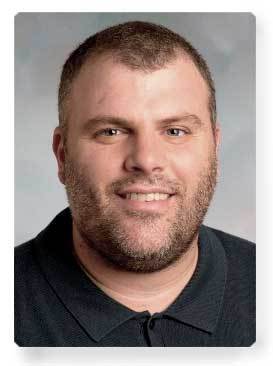 Imagine that you’re female, and that you’re involved in door to door fundraising. Would it be best (purely from a financial returns viewpoint) to be blonde or brunette? Assistant Professor Michael K. Price at the Department of Economics, University of Tennessee, Knoxville has undertaken an investigation :
Imagine that you’re female, and that you’re involved in door to door fundraising. Would it be best (purely from a financial returns viewpoint) to be blonde or brunette? Assistant Professor Michael K. Price at the Department of Economics, University of Tennessee, Knoxville has undertaken an investigation :
“This study examines how a cosmetic attribute – hair color – impacts productivity in a door-to-door fund-raising experiment. Empirical results suggest that returns to physical appearance are, on average, greater for blonde females but depend critically on characteristics of the potential donor. Further, the returns to beauty for brunette solicitors accrue largely on the extensive margin whereas the returns to beauty for blonde solicitors accrue on the intensive margin.”
The professor’s full paper can be read here : ‘Fund-raising success and a solicitor’s beauty capital: Do blondes raise more funds?‘ (Economics Letters, 100, 2008, 351-354)
Clarification: A ‘Solicitor’ in this case means ‘One who solicits’ rather than ‘A member of the legal profession qualified to deal with conveyancing, the drawing up of wills, and other legal matters’.
In the wings: A forthcoming paper from Professor Guéguen : ‘Women’s Hair Color and Donation: Blondes Received More Money’ accepted for publication in the North American Journal of Psychology. (sadly, not yet available online)

Big and/or small: One and/or the other, and both
Richard Wiseman demonstrates, in this video, some different kinds of difference between big and small:

December 24, 2012
Great names together: Pinch & Rottenberg

Trevor Pinch [pictured here, at right] and Richard Rottenberg [pictured below] sometimes collaborate, says Professor Pinch’s web page, as well as Professor Rottenberg’s. You will note that Wikipedia notes that “Trevor Pinch’s book, Confronting Nature is widely considered the definitive sociological account of the history of the solar neutrino problem, and was mentioned by Raymond Davis in his 2002 Nobel Prize acceptance speech.”

BONUS: Pinch’s study “How Aunt Ammy Gets Her Free Lunch“

December 23, 2012
Further Physics of Tumbling Toast
It was back in 1844 that the Victorian poet and satirist James Payn wrote :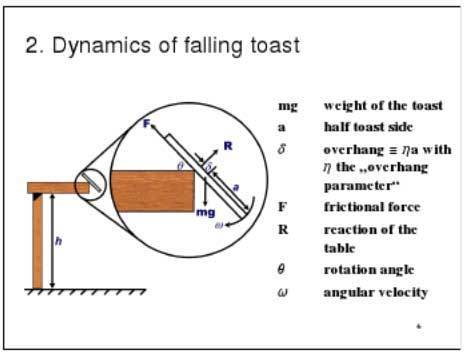
“I’ve never had a piece of toast
particularly long and wide,
but fell upon a sanded floor,
and always on the buttered-side.”
Depending on whether you are an optimist or a pessimist this poetic generalisation may or may not resonate with your standpoint. Either way, the mathematics of the ‘Tumbling toast problem’ have recently come under the scrutiny of professor Riccardo Borghi of the Dipartimento di Elettronica Applicata, Università degli Studi ‘Roma Tre’, Rome, Italy.
In the European Journal of Physics, Volume 33 Number 5, September 2012, the professor points out that :
“The numerical solution of the related Newton’s equations has been found in the space domain, without resorting to the complete time-based law of motion, with a considerable reduction of the mathematical complexity of the problem. This could allow the effect of the different physical mechanisms ruling the overall dynamics to be appreciated in a more transparent way, even by undergraduates.”
See: On the tumbling toast problem (yours for $33.00, plus taxes if applicable).
Note:
The illustration above is from an earlier inquiry into a very similar subject authored by Roland Krenn, Institute of Physics, Strong Interactions in continuum QFT, Karl Franzens Universität Graz, Austria. Available here, free of charge. ‘The Anthropomurphic principle’.
BONUS: The 1996 Ig Nobel Prize in physics was awarded to
Robert Matthews of Aston University, England, for his studies of Murphy’s Law, and especially for demonstrating that toast often falls on the buttered side. [REFERENCE: "Tumbling toast, Murphy's Law and the fundamental constants," "European Journal of Physics," vol.16, no.4, July 18, 1995, p. 172-6.]

December 22, 2012
Guidelines against body fluid transmission via CPR manikins
If you are or should be or ever might be in a situation where you might worry or should worry about the transmission of disease via a CPR manikin, this report is for you:
“Guidelines for the prevention of disease transmission in the use of CPR manikin,” Committee to Advise The American Red Cross, National Academy Press, 1984.
Here is a reproduction of part of one page:
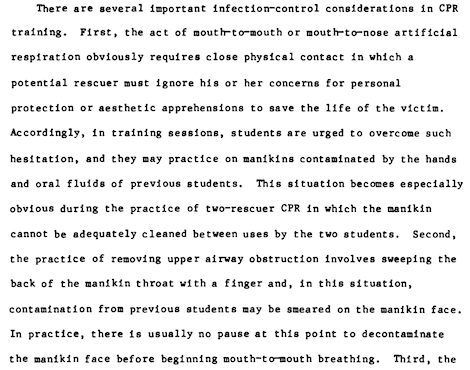

Gift e-book issues of Improbable Research!
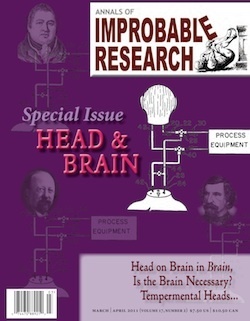 Why yes! You can give someone a gift e-book issue of the Annals of Improbable Research. Both Amazon and Barnes & Noble make that easy to do.
Why yes! You can give someone a gift e-book issue of the Annals of Improbable Research. Both Amazon and Barnes & Noble make that easy to do.
FREE ISSUE: And you can get (and if you like, then give) a free issue.
BACKGROUND: In case you haven’t heard: We invented a way to make picture-rich magazines comfy to read on both tiny (phone) and big screens, in standard e-book form.
NOW: Six issues of the magazine are available on Amazon and Barnes & Noble.
SOON: Additional issues will be up there very soon. They will soon be available on iTunes, Google, and elsewhere, as well. And we still, of course, also publish on paper.
Spread the word, please!
BONUS: We are emphatically NOT copy-protecting these e-books.

Ig Nobel winner’s turkey (and other) carving insight
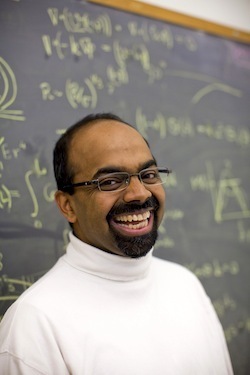 The BBC celebrates a newly published study by Mahadevan [pictured here], the man who (with colleague Enrique Cerda Villablanca) was awarded the 2007 Ig Nobel Prize in physics for studying how sheets get wrinkled. The new study is:
The BBC celebrates a newly published study by Mahadevan [pictured here], the man who (with colleague Enrique Cerda Villablanca) was awarded the 2007 Ig Nobel Prize in physics for studying how sheets get wrinkled. The new study is:
“Slicing Softly with Shear,” E. Reyssat, T. Tallinen, M. Le Merrer, and L. Mahadevan, Physical Review Letters, epub December 14, 2012.
Philip Ball, reports for the BBC’s on a topical application of the new study:
No one tries to cut up a turkey by simply pressing down hard with the blade – that’s likely merely to squash the bird. As with cutting bread, you’ll instead use a sawing motion, sliding the knife through the soft meat. But why is slicing more effective than chopping?
That’s the question investigated by Lakshminarayanan Madadevan, an applied physicist at Harvard University in Cambridge, Massachusetts, and his colleagues…. [In] an age of huge, costly international collaborations, it is heartening to know that good science can still be done with a piece of wire and a block of jelly. That is essentially what Mahedevan and colleagues have used to understand the physics of slicing and cutting. Their soft solid is a polysaccharide gelling agent extracted from algae, known as agar and widely used as a food ingredient in Asia. The researchers cut a block of this stuff using either metal wire or thin fishing tackle, stretched tautly like a cheese wire. They investigated the forces that develop in the gel when the wire is either just pushed down through the block or when it is also pulled across the surface in a slicing action.
The two cases give different results….
(Thanks to Janusz Lukasiak for bringing this to our attention.)

December 21, 2012
On the nth Day of Christmas, My True Love’s Cost Was x
Accountants can bring order to otherwise frothy undertakings. An example:
“Cost analysis: the acquisition of the items listed in a popular Christmas song,” Dianne M. Dean, Accounting, Auditing & Accountability Journal, 2007, Vol.20(5), p.790-792. The author, in Beechworth, Australia, protects her status in the profession by explaining “A humorous approach is taken”, then gives details:
“Purpose – This paper aims to cost the acquisition of the items listed in a popular Christmas song.
“Findings – It was found that there was a significant increase in costs from 2005 to 2006.”
The song, perhaps familiar to you, includes this passage:
On the twelfth day of Christmas,
my true love sent to me
Twelve drummers drumming,
Eleven pipers piping,
Ten lords a-leaping…
(Thanks to investigator Rodolfo Baggio for bringing this to our attention.)

Gift That Should Keep On Being Given?
To re-gift, or not to re-gift? This study takes a business-like approach to the question:
“The Gifts We Keep on Giving: Documenting and Destigmatizing the Regifting Taboo,” Gabrielle S. Adams (London Business School), Francis J. Flynn, (Stanford Graduate School of Business), Michael I. Norton [pictured here], (Harvard Business School), In press, Psychological Science.
(Thanks to investigator Carmen Nobel for bringing this to our attention.)

Marc Abrahams's Blog
- Marc Abrahams's profile
- 14 followers



